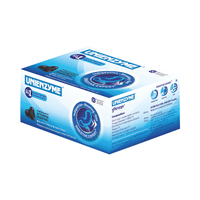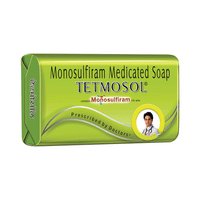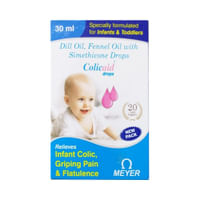Rs.289for 1 vial(s) (1 Injection each)
food interaction for 3Cef Novo
alcohol interaction for 3Cef Novo
pregnancy interaction for 3Cef Novo
lactation interaction for 3Cef Novo
food
alcohol
pregnancy
lactation
No interaction found/established
Consuming alcohol while taking 3Cef Novo 1000mg/500mg Injection may cause symptoms such as flushing, increased heart beat, nausea, thirst, chest pain and low blood pressure (Disulfiram reaction).
UNSAFE
3Cef Novo 1000mg/500mg Injection is generally considered safe to use during pregnancy. Animal studies have shown low or no adverse effects to the developing baby; however, there are limited human studies.
SAFE IF PRESCRIBED
3Cef Novo 1000mg/500mg Injection is safe to use during breastfeeding. Human studies suggest that the drug does not pass into the breastmilk in a significant amount and is not harmful to the baby.
SAFE IF PRESCRIBED
SALT INFORMATION FOR 3Cef Novo
Cefoperazone(1000mg)
Uses
Cefoperazone is used in the treatment of bacterial infections.
How it works
Cefoperazone is an antibiotic. It kills the bacteria by preventing them from forming the bacterial protective covering (cell wall) which is needed for them to survive.
Common side effects
Diarrhea, Vomiting, Fever, Itching, Decreased hemoglobin, Decreased hematocrit level, Decreased white blood cell count (neutrophils), Positive Coombs test, Low blood platelets, Increased white blood cell count (eosinophils), Injection site phlebitis, Increased aspartate aminotransferase, Increased alanine aminotransferase, Increased alkaline phosphatase level in blood, Jaundice, Urticaria, Maculopapular rash, Injection site pain, Hypoprothrombinemia, Hypersensitivity, Hemorrhage, Pseudomembranous colitis, Stevens-Johnson syndrome, Toxic epidermal necrolysis
Sulbactam(500mg)
Uses
Sulbactam is used in the treatment of severe bacterial infections. It treats severe bacterial infections (most commonly pneumonia, bacteremia and skin and skin structure infections) caused by the pathogen Acinetobacter baumanii.
How it works
Sulbactam is a beta-lactamase inhibitor. It works by blocking an enzyme called beta lactamase produced by bacteria to inactivate antibiotics. Sulbactam is frequently combined with beta-lactam antibiotics, such as ampicillin, cefoperazone, meropenem. As a single medicine, it treats infection caused by a type of bacterium called Acinetobacter baumanii. This activity is mediated by its interaction with certain proteins.
Common side effects
Diarrhea, Injection site pain
SUBSTITUTES FOR 3Cef Novo
934 Substitutes
934 Substitutes
Sorted By
 Rs. 267.30save 93% more per ml of Injection
Rs. 267.30save 93% more per ml of Injection Rs. 103.31save 97% more per ml of Injection
Rs. 103.31save 97% more per ml of Injection Rs. 499.25pay 59% more per Injection
Rs. 499.25pay 59% more per Injection Rs. 314pay 6% more per Injection
Rs. 314pay 6% more per Injection Rs. 257save 91% more per ml of Injection
Rs. 257save 91% more per ml of Injection
Expert advice FOR 3Cef Novo
- Your doctor has prescribed Cefoperazone to cure your infection and improve your symptoms.
- Do not skip any doses and finish the full course of treatment even if you feel better. Stopping it early may make the infection harder to treat.
- Discontinue Cefoperazone and inform your doctor immediately if you get a rash, itchy skin, swelling of face and mouth, or have difficulty in breathing.
- Diarrhea may occur as a side effect but should stop when your course is complete. Inform your doctor if it does not stop or if you find blood in your stools.
- Take it with food to avoid an upset stomach.
- Avoid consuming alcohol while taking Cefoperazone as it may cause increased side effects.
Frequently asked questions FOR 3Cef Novo
Cefoperazone
Q. Is Cefoperazone effective?
Cefoperazone is effective if used in the dose and duration advised by your doctor. Do not stop taking it even if you see improvement in your condition. If you stop using Cefoperazone too early, the symptoms may return or worsen.
Q. Is Cefoperazone bactericidal or bacteriostatic?
Cefoperazone is primarily bactericidal(one which kills the causative organisms) but it may be bacteriostatic (one which slows down the growth of bacteria) also. Its activity depends on the organism, tissue penetration, dosage, and rate of organism multiplication.
Q. How does Cefoperazone act?
Cefoperazone acts by adhering to the proteins synthesized by the bacteria, thereby inhibiting the organisms to develop their protective covering known as cell wall. This kills the bacteria.
Sulbactam
Q. Why is Sulbactam added to other antibiotics?
Sulbactam added to other antibiotics like ampicillin, cefoperazone, etc., because Sulbactam contains Sulbactam, a beta-lactamase inhibitor, which reduces resistance and enhances the activity of other antibiotics like ampicillin, cefoperazone, etc., against the bacteria.
Q. Who should not take Sulbactam?
Sulbactam should not be taken by an individual if he/she had an allergic reaction to ampicillin, sulbactam, or any penicillin antibiotic (such as penicillins or cephalosporins), or if he/she has a history of liver problems caused by ampicillin/sulbactam.
Q. What should I discuss with my doctor before receiving Sulbactam?
Before taking Sulbactam, you should tell your doctor if you have ever had an allergic reaction to Sulbactam or any similar medicine. Inform the doctor if you have any type of allergy, asthma or breathing problems, heart disease or kidney disease. Let your doctor know about all the medicines that you may be taking as they may affect or be affected by Sulbactam. Pregnant or breastfeeding mothers should also seek their doctor’s advice before taking Sulbactam.























